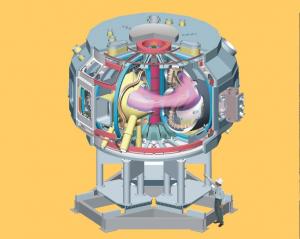Meanwhile, in the stellarator world
2 Apr 2014
-
John Greenwald, Princeton Plasma Physics Laboratory
The Quasi-Axisymmetric Stellarator Research (QUASAR) experiment represents the first of a new class of fusion reactors based on the innovative theory of quasi-axisymmetry. © PPPL
Completion of a promising experimental facility at the US Department of Energy's Princeton Plasma Laboratory (PPPL) could advance the development of fusion as a clean and abundant source of energy for generating electricity, according to a PPPL paper published this month in the journal IEEE Transactions on Plasma Science.
The facility, called the Quasi-Axisymmetric Stellarator Research (QUASAR) experiment, represents the first of a new class of fusion reactors based on the innovative theory of quasi-axisymmetry, which makes it possible to design a magnetic bottle that combines the advantages of the stellarator with the more widely used tokamak design. Experiments in QUASAR would test this theory. Construction of QUASAR — originally known as the National Compact Stellarator Experiment — was begun in 2004 and halted in 2008 when costs exceeded projections after some 80 percent of the machine's major components had been built or procured.
"This type of facility must have a place on the roadmap to fusion," said physicist George "Hutch" Neilson, the head of the Advanced Projects Department at PPPL.
Both stellarators and tokamaks use magnetic fields to control the hot, charged plasma gas that fuels fusion reactions. While tokamaks put electric current into the plasma to complete the magnetic confinement and hold the gas together, stellarators don't require such a current to keep the plasma bottled up. Stellarators rely instead on twisting — or 3D —magnetic fields to contain the plasma in a controlled "steady state."
Stellarator plasmas thus run little risk of disrupting — or falling apart — as can happen in tokamaks if the internal current abruptly shuts off. Developing systems to suppress or mitigate such disruptions is a challenge that builders of tokamaks like ITER must face.
Read the whole article on PPPL Princeton Journal Watch.


